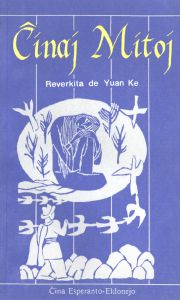|
Ĉinaj mitoj

|
|
Ĉinaj mitoj / Chinese Myths |
| In Esperanto | Angle |
|---|---|
Jen interesa libreto, kiu povas servi kiel enkonduko al fremda por Okcidentanoj mitaro. Ĝi komenciĝas je la kreo de la universo fare de la dio Panku, daŭrigas je la kreo de la homaro fare de la diino Nüwa, kaj iras tra pluraj stadioj ĝis la imperiestriĝo de Yu, kiu, sekve sian patron Gun, finbridis la 22-jaran diluvon, kiu kovris la teron dum la regado de la imperiestro Yao. (Ĉinaj mitoj ĉiam estas pli grandskalaj ol la okcidentaj, en kiuj la terkovra diluvo daŭris nur 40 tagojn kaj 40 noktojn.) |
This is an interesting booklet that can serve as an introduction to a mythology alien to Westerners. It begins with the creation of the universe by the god Panku, continues with the creation of mankind by the goddess Nüwa, and goes through several stages up to the accession to emperorship of Yu who, following his father Gun, finished reining in the 22-year flood that covered the earth during the rule of the emperor Yao. (Chinese myths are always on a grander scale that western ones, in which the earth-covering flood lasted only 40 days and 40 nights.) |
Estas interese, kiel oni povas sekvi la fadenojn tra la noveloj, spurante laŭ unu persono al ties postvenintoj. Ŝajne nur unu fabelo estas tute sendependa de la aliaj; temas pri la konata "Bovisto kaj teksistino", kiu klarigas pri la deveno de la Arĝenta Rivero (okcidente: Lakta Vojo). Por mi, ankaŭ aparte interesa estis la antaŭfina novelo, "Rakonto pri Yi kaj Chang'e", kiu en sia fino klarigas, kiel Chang'e atingis la lunon (kion ŝi ne faris honeste). |
It is interesting how you can follow the threads through the stories, tracing from one person to his successors. It seems that only one tale is completely independent of the others; this is the well-known "Cowherd and Weaver-girl", which explains the origin of the Silver River(in the West: the Milky Way). For me, the penultimate short story, "The Story of Yi and Chang'e", which in its end explains how Chang'e reached the moon (she did not do so honestly) was of special interest. |
Ankaŭ interesa por mi estis la arbo nomata Jianmu, ŝtuparo al la ĉielo, kies "maldika kaj longa trunko senbranĉa rekte skrapis la ĉielon, ĝia supro kun zigzagaj branĉoj forme similis al ombrelo, kaj ĝiaj radikoj interkruciĝis sub la tero" (p. 11), kiu memorigas iomete pri la skandinavia Yggdrasil. Verŝajne tro malgranda por simili al Yggdrasil estis la giganta morusarbo ĉe la bordo de la Okcidenta Maro, kiu "altis je pli ol tridek mil metroj" (p. 45). |
I also found the tree named Jianmu, stairway to heaven, whose "thin and long branchless trunk directly scraped the sky, its top with zig-zag branches resembled an umbrella in form, and its roots crossed and recurssed under the earth" (p. 11), interesting; it reminds a bit of the Scandinavian Yggdrasil. The giant mulberry tree on the shore of the Western Sea, which "was more than thirty thousand meters tall" (p. 45), is apparently too small to resemble Yggdrasil. |
Atentindaj estas pluraj vortoj, kiujn mi antaŭe ne konis. Inter ili estas pandiono (angle: fish eagle), apanaĝi (to grant an appanage), lanio (shrike), palumbo (ring dove), trerono (Treron permayna -- mi ne povis trovi la anglan nomon de tiu birdo), paruo (titmouse), tulo (tulle), osmanto (tiun vorton mi eĉ ne trovis en PIV), belvedero (belvedere). |
Worth noting are several words that I didn't know before. Among them are pandiono (English: fish eagle), apanaĝi (to grant an appanage), lanio (shrike), palumbo (ring dove), trerono (Treron permayna -- I couldn't find the English name of this bird), paruo (titmouse), tulo (tulle or silk net fabric), osmanto (I didn't even find this word in PIV), belvedero (belevedere). |
Eraroj estas malmultaj. Dufoje en "Bovisto kaj teksistino" oni uzas -EBL- kun netransitiva verbo (neparolebla, neflugebla), kie devas esti -POV-, eventuale -IV- (ekz. neparolpova, neparoliva). Sur p. 83 Gun, frontante la diluvon, estas "tre ĉagrena" (ĉagrenita). Krom tio, temas pliparte pri maloftaj stilaj malglataĵoj de la speco: "Yi kaj lia edzino vizitis Yao en sufoke varmega pajla kabano, kiu maltrankviliĝis pro la sekegeco" (eble pli bone: "Yi kaj lia edzino vizitis en sufoke varmega pajla kabano Yao, kiu maltrankviliĝis pro la sekegeco" -- p. 74). |
There are few errors. -EBL- is used with an intransitive verb twice in "Cowherd and "Weaver-girl" (neparolebla, neflugebla), where -POV- or perhaps -IV- should be used (e.g. neparolpova, neparoliva). On p. 83, Gun, fancing the flood, is "tre ĉagrena" (ĉagrenita). Besides this, for the most part we see the occasional stylistic wobble of the sort: "Yi kaj lia edzino vizitis Yao en sufoke varmega pajla kabano, kiu maltrankviliĝis pro la sekegeco" (perhaps better: "Yi kaj lia edzino vizitis en sufoke varmega pajla kabano Yao, kiu maltrankviliĝis pro la sekegeco" -- p. 74). |
Leginda (kaj cetere malmultekosta) libreto. |
A booklet worth reading and, in addition, inexpensive. |








